Gujarat Board Textbook Solutions Class 10 Science Chapter 6 Life Processes
Gujarat Board Textbook Solutions Class 10 Science Chapter 6 Life Processes
GSEB Solutions Class 10 Science Chapter 6 Life Processes
Gujarat Board Class 10 Science Life Processes Textbook Questions and Answers
Question 1. The kidneys in human beings are a part of the system for –
(a) nutrition
(b) respiration
(c) excretion
(d) transportation
Answer:
(c) excretion
Question 2. The xylem in plants are responsible for –
(a) transport of water
(b) transport of food
(c) transport of amino acids
(d) transport of oxygen
Answer:
(a) transport of water
Question 3. The autotrophic mode of nutrition requires –
(a) carbon dioxide and water
(b) chlorophyll
(c) sunlight
(d) all of the above
Answer:
(d) All of the above
Question 4. The breakdown of pyruvate to give carbon dioxide, water and energy takes place in –
(a) cytoplasm
(6) chloroplast
(c) mitochondria
(d) nucleus
Answer:
(c) mitochondria
Question 5. How are fats digested in our bodies? Where does this process take place?
Answer:
Fats are digested in the small intestine. The secretion of liver, called bile, breaks down the large globules of fat into smaller globules. This is called emulsification of fats. The bile also makes the medium alkaline so that the pancreatic enzyme containing lipase further digest fats to form fatty acids. The alkaline medium is required for pancreatic enzyme to act on lipase.
Question 6. What is the role of saliva in the digestion of food?
Answer:
Saliva contains enzymes, salivary amylase and is released in our mouth. It breaks down starch into sugar (complex carbohydrates into simpler ones).
Question 7. What are the necessary conditions for autotrophic nutrition and what are its by products?
Answer:
For autotrophic nutrition to take place the conditions necessary are light, carbon dioxide and water should reach a cell which contains chlorophyll in it. Water first splits to release oxygen and hydrogen.
This process is photolysis of water. Hydrogen then combines with carbon dioxide to form glucose. The by product of the autotrophic nutrition is oxygen which is released through stomata.
Question 8. What are the differences between aerobic and anaerobic respiration? Name some organisms that use the anaerobic mode of respiration.
Answer:
Aerobic respiration:
- Takes place in presence of oxygen.
- Its end products are carbon dioxide and water.
- More energy is released.
- It takes place in cytoplasm and mitochondria.
- Complete oxidation of glucose takes place.
Anaerobic respiration:
- Takes place in absence of oxygen.
- Its end products are ethanol and carbon dioxide.
- Less energy is released.
- It takes place only in the cytoplasm.
- Incomplete oxidation of glucose takes place.
Some organisms that use the anaerobic mode of respiration are yeast and bacteria.
Question 9. How are the alveoli designed to maximise the exchange of gases?
Answer:
The alveoli are present at the terminal of bronchioles. They are balloon-shaped structures which increases the surface area for the exchange of gases and are richly supplied with blood vessels to take the oxygen to different cells.
Question 10. What would be the consequences of a deficiency of haemoglobin in our bodies?
Answer:
Haemoglobin is a red pigment present in our blood which carries oxygen to all the parts of the body. If there is deficiency of haemoglobin, then amount of oxygen reaching our body cells will decrease, which may lead to release of less energy in our body, leading to a disease called anaemia. Breathlessness, tiredness and weakness are the symptoms of anaemia.
Question 11. Describe double circulation in human beings. Why is it necessary?
Answer:
The heart of human beings consist of two sides right and left. The right side of the heart receives de-oxygenated blood from the cells and tissues and sends it further for purification to lungs.
The left side of the heart receives oxygenated blood from lungs which is pumped further and sent to all the parts of the body through blood vessels. This is called double circulation. The energy demand of human beings is too large and hence it is necessary for the separation of oxygenated and deoxygenated blood to meet this energy demand.
Question 12. What are the differences between the transport of materials in xylem and phloem?
Answer:
Transport in Xylem:
- Water and mineral salts are transported.
- The transport is generally passive.
- Vessels and tracheids are dead cells.
Transport in Phloem:
- Food in aqueous form is translocated.
- The transport is active.
- Sieve tubes and companion cells are living cells.
Question 13. Compare the functioning of alveoli in the lungs and nephrons in the kidneys with respect to their structure and functioning.
Answer:
Alveoli:
- It is the structural and functional unit of lungs.
- It is thin walled, has a large surface area and is richly supplied with blood vessels.
- It removes carbon dioxide from the blood.
Nephron:
- It is the structural and functional unit of kidneys.
- It is thin walled, has a large surface area and is richly supplied with blood vessels.
- It removes nitrogenous wastes from the blood.
Gujarat Board Class 10 Science Life Processes Additional Important Questions and Answers
Very Short Answer Type Questions
Question 1. What is the mode of nutrition when organism use simple substances like CO2 and water to prepare food inside the body?
Answer:
Autotrophic.
Question 2. What are enzymes?
Answer:
Enzymes are bio-catalyst which help in faster biochemical processes.
Question 3. What is nutrition?
Answer:
It is the process by which a source of energy (food) is transferred from outside the body to inside of an organism.
Question 4. What are life processes?
Answer:
The processes that together perform the maintenance functions of living organisms are called life processes.
Question 5. Which are the most common chemical reactions in a body?
Answer:
Oxidation-reduction reaction.
Question 6. Name an enzyme secreted by salivary glands as well as pancreas.
Answer:
Amylase.
Question 7. In what form is food energy stored in plants and animals?
Answer:
- Plants – Starch
- Animals – Glycogen.
Question 8. Name the process by which energy is obtained by living organism.
Answer:
Respiration.
Question 9. What is peristaltic movement?
Answer:
The rythmic, contraction and relaxation movement of the alimentary canal is called peristaltic movement.
Question 10. In desert plants the stomata remains closed during the day and opens at night. How do these plants photosynthesize?
Answer:
Desert plants take up CO2 at night and prepare an intermediate which is acted upon by the energy absorbed by the chlorophyll during the day.
Question 11. Why is nitrogen essential for plants?
Answer:
It is required for the synthesis of proteins and other compounds.
Question 12. Name the intermediate 3-carbon molecule formed from six-carbon molecule of glucose during respiration.
Answer:
Pyruvate.
Question 13. What is the site in cells where glucose is converted into 3-carbon molecule of pyruvate?
Answer:
Cytoplasm.
Question 14. Why are the rings of cartilage present in air tube Trachea?
Answer:
Rings of cartilage prevents the trachea from collapsing.
Question 15. What products are formed during respiration in our muscles when there is less supply of oxygen?
Answer:
Lactic acid.
Question 16. Why is more energy released in aerobic respiration than in anaerobic respiration?
Answer:
It is because complete oxidation of glucose takes place in aerobic respiration and incomplete oxidation in anaerobic respiration.
Question 17. Where is water absorbed in the digestive system?
Answer:
Water is absorbed by villi of the large intestine. Some water is also absorbed by walls of large intestine.
Question 18. What are the two functions of the kidneys?
Answer:
Excretion and osmoregulation.
Question 19. Name the muscles of stomach which regulate the release of food from stomach to small intestine.
Answer:
Sphincter muscle.
Question 20. Name two organisms that break down the food outside the body and then absorb it.
Answer:
Fungi – bread mould, yeast, mushroom (Saprophytes).
Question 21. What is the impact of leakage or loss of blood upon the pressure?
Answer:
Blood pressure decreases.
Question 22. Name the respiratory pigment in higher animals.
Answer:
Haemoglobin.
Question 23. Name the blood vessel which carries blood away from the heart for purification.
Answer:
Pulmonary artery.
Question 24. What is lymph?
Answer:
It is an extracellular fluid used in transportation.
Question 25. What is the full form of ATP?
Answer:
Adenosine Triphosphate.
Short Answer Type Questions
Question 1. Name two parasitic plants and animals.
Answer:
Parasitic plants – Cuscuta and Orchids
Parasitic animals – Lice, leech, tapeworm
Question 2. How does nutrition occur in amoeba?
Answer:
Amoeba gives out pseudopodia which fuse over the food particle forming a food vacuole. Inside the food vacuole, complex substances are broken down into simpler ones which then diffuse into the cytoplasm. The remaining undigested material is moved to the surface of the cell and thrown out.

Question 3. Draw a diagram of open and closed stomata.
Answer:

Question 4. What causes the opening and closing of stomata?
Answer:
The opening and closing of stomata is a function of the guard cells. When water flows into the guard cells, they swell causing the stomata to open. When the guard cell shrinks, the stomata closes.
Question 5. Explain digestion in the mouth.
Answer:
In the mouth the food is ground with the teeth. The saliva in the mouth contains enzyme called salivary amylase. This breaks down starch into sugar.
Question 6. Why is respiration an exothermic reaction?
Answer:
It is because energy stored in the food is released in respiration. This energy is used to synthesize ATP molecules. The ATP molecules can be used to provide energy for the different reactions taking place in the cell.
Question 7. When is lactic acid formed in our muscles?
Answer:
Sometimes there is lack of oxygen in our muscle cells hence the pyruvate breaks down to form lactic acid (three carbon compound). The build up of lactic acid in our muscles during sudden activity causes cramps.
Question 8. What is the range of pH in small intestine and stomach respectively?
Answer:
pH in small intestine is greater then 7 (basic or alkaline).
pH in stomach is less than 7 (acidic medium).
Question 9. Name the glands associated with common duct in digestive system. Also name their secretions.
Answer:
Liver – Secretes bile juice.
Pancreas – Secretes pancreatic juice which contains amylase, lipase and trypsin.
Question 10. Write two important functions of transpiration in plants.
Answer:
Transpiration is loss of water from stomatal pores. It regulates the temperature and also causes the suction pull due to which upward movement of water and minerals take place.
Question 11. What do the following transport:
- Xylem?
- Pulmonary artery?
- Pulmonary vein?
- Vena cava?
Answer:
- Xylem – Transports water and minerals.
- Pulmonary artery – deoxygenated blood to lungs.
- Pulmonary vein – oxygenated blood to left atrium.
- Vena cava – bring deoxygenated blood to right atrium of the heart.
Question 12. Why are the walls of ventricles thicker and more muscular than the walls of atria?
Answer:
Ventricles have to apply lot of pressure and push the blood out of the heart to reach all the body cells. Hence its walls are thicker and muscular as compared to the walls of atria.
Question 13. Write one feature which is common to each of the following pairs of terms:
- glycogen and starch
- chlorophyll and haemoglobin
- gills and lungs
- arteries and veins
Answer:
- glycogen and starch – both are carbohydrates and stored food products.
- chlorophyll and haemoglobin – both are pigments
- gills and lungs – both are respiratory organs
- arteries and veins – both are blood vessels
Question 14. Explain the process of breathing.
Answer:
- When we inhale air, chest cavity expands and air rushes in to fill the expanded alveoli.
- The exchange of gases takes place in the alveoli (by diffusion).
- When we exhale, our chest cavity contracts and air containing carbon dioxide and water vapour is expelled out.
Question 15. What is residual volume?
Answer:
Volume of air remaining in the lungs even after a forcible expiration is residual volume.
Question 16. Name the components of xylem and phloem.
Answer:
Xylem – Tracheids, vessels, Xylem parenchyma and Xylem fibres
Phloem – Sieve tubes, companion cells, phloem parenchyma and phloem fibres.
Question 17. What is the function of lymph?
Answer:
Lymph carries digested and absorbed fat from intestine and drains excess fluid from extracellular space back into the blood.
Question 18. Name the components of blood.
Answer:
- Plasma – It is the fluid in which other cells are suspended.
- R.B.C. – Red blood cells contain haemoglobin which is responsible to carry oxygen.
- W.B.C. – White blood cells helps in killing germ.
- Platelets – Helps in blood clotting during some injury.
Question 19. Give the events that occur during photosynthesis.
Answer:
The following events occur during photosynthesis:
- Absorption of light energy by chlorophyll.
- Conversion of light energy to chemical energy and splitting of water molecules into hydrogen and oxygen.
- Reduction of carbon dioxide to carbohydrates.
Question 20. Describe the digestive system.
Answer:
The different parts of the digestive system are as follows:
- Buccal cavity opens outside through the mouth. It has the tongue, teeth and the opening of the salivary gland.
- Buccal cavity leads to oesophagus.
- The oesophagus opens into the stomach. The wall of the stomach contains gastric glands.
- The stomach opens into the duodenum. This opening is regulated by a sphincter muscle which releases small amount of food at a time.
- The duodenum receives the secretions of the liver and the pancreas.
- From the duodenum the food passes into the small intestine. The inner wall of the small intestine has a number of finger-like projections called villi. The villi increases the surface area and are richly supplied with blood vessels.
- The small intestine opens into the large intestine.
- The terminal portion of the large intestine is called the rectum that opens out through the anus.
Question 21. Explain the digestion in stomach.
Answer:
The gastric glands present in the stomach secrete:
- HCl – It kills the bacteria ingested with food and makes the medium of food acidic so as to facilitate the action of the enzyme pepsin.
- Pepsin – It helps to digest proteins.
- Mucus – It protects the inner lining of the stomach from the action of HCl.
Question 22. Explain digestion in the small intestine.
Answer:
In the first part of the small intestine the secretion of the liver called bile and the pancreatic juice are received. The bile salts break down the large globules of fat into smaller globules. This is called emulsification. The bile also makes the food alkaline so that the pancreatic enzymes can act. The pancreatic enzymes contain trypsin for digesting proteins and lipase for digesting fats. The walls of the small intestine secrete intestinal juices which finally digest the food as follows:
- Proteins → amino acids
- Fats → fatty acids and glycerol
- Carbohydrates → glucose
Question 23.
Give the characteristics of any respiratory surface.
Answer:
Any respiratory surface e.g. gills, skin, or alveoli must have the following features:
- It should be thin.
- It should be moist.
- The surface area should be large.
- It should be richly supplied with blood vessels.
These features will ensure quick diffusion of gases.
Question 24. Give the pathway of air in the human respiratory system.
Answer:

Question 25. Draw a labelled diagram of transverse section of a leaf.
Answer:

Question 26. Explain breathing mechanism.
Answer:
The cartilaginous diaphragm when contracts, increases the surface area for lungs which spreads thereby reducing the air pressure in it. The pressure of air at the nostrils is more and hence the air flows from higher pressure area to lower pressure area i.e. lungs. This is called inhalation. When the diaphragm relaxes, it pushes the lungs thereby increasing the pressure on them and the surface area reduces and hence the pressure of air in the lungs is more which is forced/given out from the nostrils. This is called exhalation.

Question 27. What are the various types of heterotrophic nutrition? Give examples of each type.
Answer:
(i) Saprophytic nutrition: In this an organism feeds on dead and decaying organic matter (i.e. plant or animal matter). These organisms break down the food outside the body and then absorb it.
Example : fungi, yeast, mushroom, bacteria.
(ii) Parasitic nutrition: In this type of nutrition an organism derives its food from the body of other living organism called host, thereby harming it.
Example : leech, lice, orchids, cuscuta, etc.
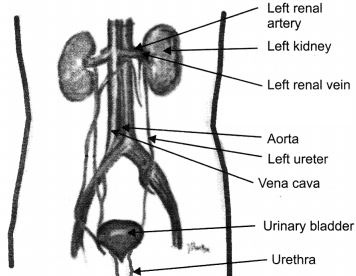
(iii) Holozoic nutrition: In this an organism takes in the complex food materials into its body by ingestion. The food is acted upon by enzymes to break it down into simpler ones through digestion. The digested food is absorbed and then assimilated to release energy. The unabsorbed food is thrown out called egestion.
Question 28. Name the excretory organs of the human excretory system. Show all the organs with a labelled diagram.
Answer:
Excretory Organ:
- A pair of kidneys
- A pair of ureter
- A urinary bladder
- A urethra
Question 29.
Differentiate between arteries and veins.
Answer:
Arteries:
- Arteries are thick walled.
- They are deep seated.
- They carry blood away from heart.
- The arteries carry oxygenated blood.
- No valves are present in it.
Veins:
- Veins are thin walled.
- They are superficial.
- They carry blood to the heart.
- The veins carry deoxygenated blood.
- Valves are present in it.
Question 30. Bile is made in the liver, stored in the gall bladder and passes into the small intestine. Describe the role of bile in digestion.
Answer:
Bile provides the alkaline medium in the small intestine which further helps in the action of pancreatic amylase, lipase and trypsin (protease) to digest the food. It neutralises the acid that comes from the stomach.
Question 31. Label I? Q and R in the alimentary canal above and state the function of each. Explain what happens to fat at R.
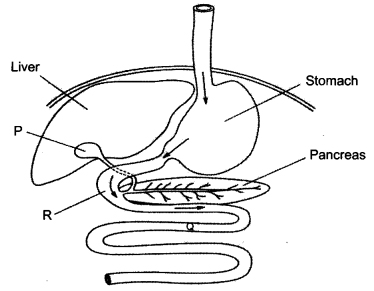
Answer:
P is gall bladder, it stores the bile secreted by liver.
R is small intestine and helps in the complete digestion of food where pancreatic enzymes are released.
Q is the lower part of the small intestine where the absorption of digested food takes place.
At R the fat is emulsified and the big fat globule is broken down into the small ones.
Question 32. Name the organs where the following fuhctions in humans are performed
- Absorption of food.
- Absorption of water
Answer:
- Small intestine.
- Large intestine.
Question 33. Name the respiratory organs of –
- fish
- mosquito
- earthworm
- frog
- cockroach
Answer:
The respiratory organs of –
- fish is gills
- mosquito is trachea
- earthworm is moist skin
- frog: on land lungs and in water skin
- cockroach: spiracles and trachea.
Question 34. (a) The composition of the air inside the lungs changes during breathing.
(i) State three differences between inhaled air and the exhaled air.
(ii) Describe three features of the alveoli which assist gaseous exchange.
(b) (i) State what is meant by anaerobic respiration.
(ii) Where does anaerobic respiration occur in human?
Answer:
(a) (i) Inhaled air contains more oxygen and less carbon dioxide, and less water vapour then exhaled air.
(ii) Three features of the alveoli which assist gaseous exchange:
- The wall of the alveolus is one-cell thick
- There is a moist surface to the alveoli
- There are large number of alveoli – the air in the alveoli is constantly replaced.
(b) (i) The release of energy by the break down of glucose in the cells without the use of oxygen is called anaerobic respiration.
(ii) In muscle cells
Long Answer Type Questions
Question 1.
(a) What is photosynthesis? Give an equation to show photosynthesis.
(b) What are the various steps involved in the above reaction?
Answer:
(a) The process of making food by green plants in the presence of sunlight, chlorophyll, water and carbon dioxide, is called photosynthesis.
![]()
(b) Various steps involved in the above reaction are:
- Absorption of light energy by chlorophyll.
- Conversion of light energy to chemical energy and splitting of water molecules into hydrogen and oxygen.
- Reduction of carbon dioxide to carbohydrates.
Question 2.
(a) What is the importance of stomatal pores?
(b) Where are they present?
(c) How do they open and close?
Answer:
(a) Stomata pores are tiny pores which allow the exchange of gases like oxygen and carbon dioxide for photosynthesis and respiration. Flow of water also takes place through it i.e. transpiration.
(b) The stomata pores are present more on the lower side of the leaf.
(c) The opening and closing of stomata is controlled by guard cells. When the guard cells swell by absorbing water, the stomata pores open. When the guard cells shrink by losing water the stomata pores close.
Question 3.
(a) Name all the digestive enzymes present in our digestive system.
(b) Explain the process of digestion of carbohydrates, fats and proteins.
(c) Why do people complain of acidity problems on consuming too much of fats and proteins?
Answer:
(a) The digestive enzymes present in our system are: Salivary amylase, pepsin, trypsin, lipase, pancreatic amylase.
(b) Carbohydrates : It is acted upon by salivary amylase in mouth which convert complex insoluble starch into simpler sugar. The food with carbohydrate if not digested in mouth then it is digested by amylase from pancreas to form glucose.
Fats : Bile from liver breaks the big globules of fats into smaller ones and is acted upon by lipase from pancreas which digest fats into fatty acids.
Proteins : Proteins are first digested by pepsin in stomach to form peptones. This is further digested by trypsin from pancreas to form amino acids. The enzymes present in small intestine finally convert protein to amino acids, complex carbohydrates into glucose and fats into fatty acid and glycerol.
(c) Fats and proteins containing/rich food on digestion releases fatty acids and amino acids respectively. Hence large amount of acid is formed in the body which leads to acidic problems.
Question 4.
(a) Explain, how urine is produced in human body?
(b) What are the excretory wastes in plants?
Answer:
(a) Renal artery carrying all the impurities in blood reaches kidney. In kidney, there are small functional units called nephron which receives this blood and the impurities along with water is squeezed out in Bowman’s capsule. It is due to the glomerulus Le., the coiled structure of afferent renal artery.
The water and impurities are collected in a tubule which enters the ureter. After filtration, reabsorbtion of required, useful products takes place before it enters the ureter. Finally ureter receives the urine, with lot of urea in water and is collected in urinary bladder.

(b) Excretory wastes in plants:
- The waste product of photosynthesis is oxygen and the waste product of respiration is carbon dioxide.
- Excess of water is lost by transpiration.
- Plants store waste material in leaves which are then shed.
- Plants have tissues made up of dead cells where waste products can be stored, e.g. gums, resin in old xylem.
- Waste products can also be stored in cellular vacuoles.
- Plants also excrete some waste substances into the soil around them.
Question 5.
(a) Give five functions of blood.
(b) “Fishes show single circulation”. Explain.
Answer:
(a) Functions of blood:
- Plasma transports food, carbon dioxide and nitrogenous waste in dissolved form.
- Red blood cells carry oxygen to each and every cells.
- White blood cells act as soldiers of our body and kill germs.
- Platelets help in blood clotting, plugs the leakage.
- It maintains our body temperature.
(b) Fishes have only two chambers in their hearts, the blood is pumped to the gills for getting oxygenated and from there it passes directly to rest of the body. Thus, the blood goes only once through the heart during one cycle of passage through the body.
Question 6.
(a) Draw a sectional view of human heart and label on it, aorta, right ventricle and pulmonary vein.
(b) State the functions of the following components of transport system:
(i) Blood
(ii) Lymph
Answer:
(a) Diagram of human heart:

(b) (i) Functions of Blood:
- It maintains body temperature.
- Transports material like food, water and amino acids.
- Maintains immunity, fights with the germs.
- Helps in clotting, in case of injury
- It transports oxygen to maintain energy levels.
(ii) Functions of Lymph:
- It transports fat.
- It carries digested and absorbed fat from intestine.
- It drains excess fluid from extracellular space back into the blood.
Questions On High Order Thinking Skills (Hots)
Question 1.
(a) What is this structure called and give its state-open or closed?
(b) Where are they present?
(c) What controls the opening and closing of it?
(d) Draw the opposite figure to this.
Answer:
(a) Open stomata
(b) In leaves
(c) Guard cells
(d) Closed stomata
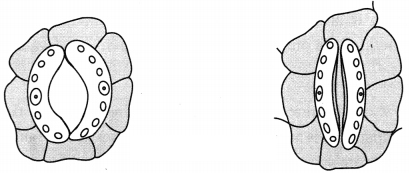
Question 2.
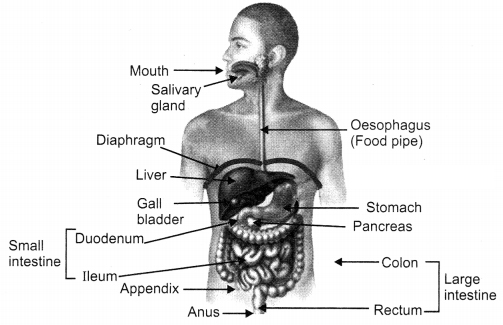
Answer the following questions based on the above figure.
(i) The organ that produces pepsin.
(ii) The alkaline medium producing organ.
(iii) It helps in absorbtion of digested food.
(iv) It help in absorbtion of water.
(v) The part that controls the exit of the waste materials.
Answer:
(i) Stomach
(ii) Liver
(iii) Villi
(iv) Large intestine
(v) Rectum
Question 3.
Three organisms ate food in the form of glucose and the end products after respiration are: .
a – ethanol + CO2
b – CO2 + H2O
c – Lactic acid + water
Explain how is this possible?
Answer:
(a) because of anaerobic respiration; (fermentation)
(b) because of aerobic respiration
(c) because of anaerobic respiration in muscle cells.
Question 4.
Name the following in human system:
- Balloon like structures richly supplied with blood capillaries.
- Prevents the back flow of blood in heart.
- Squeeze out the water with amino acids and other wastes and separates from the blood.
- Bring impure blood to kidney.
- Rythmic contraction and relaxation of walls of digestive system.
Answer:
- Alveoli
- Valve
- Bowman’s capsule
- Afferent artery
- Peristalsis
Question 5.
Name the excretory wastes of the following:
- Digestive systems
- Kidney
- Skin
- Lungs
- Plants stem
- Leaves
Answer:
- Faeces
- Urea
- Sweat
- CO2
- Resin
- O2, H2O and CO2
Question 6.
Give the role of the following in plants and animals:
- Guard cells
- Tracheids and vessels
- Lymph
- Phloem
- Bio-catalyst
Answer:
- Stomatal opening
- Transport of water
- Fat transport
- Transport of food
- Speeding up digestive process
Practical Based Questions (Solved)
Question 1.
Before testing leaves for the presence of starch, the green chlorophyll must be removed. The chlorophyll can be removed by boiling the leaf in ethanol.
(i) Describe how ethanol can be boiled safely.
(ii) Suggest why the chlorophyll needs to be removed
Answer:
As ethanol is highly flammable it should be handled very carefully. The test tube should be kept containing ethanol in the beaker containing water and then a leaf should be placed in it. If any ethanol comes in contact with hands if need to be washed away. Place the beaker on the tripod stand having wire gauze over it.
Turn the burner on and on gentle flame allow the alcohol to be warm on water bath so that the chlorophyll can be removed. Chlorophyll is removed so that colour changes can be observed carefully.
Question 2.
A student wanted to find out if starch was present in both leaves grown in direct sunlight and leaves grown in the shade. Plan an investigation to determine if starch is present in both types of leaf.
Answer:
Student should pluck both the leaves and boil them separately in the alcohol kept in water bath to remove the chlorophyll. Wash both the leaves with distilled water and add few drops of iodine solution on both the leaves kept flat on white tile. The part of the leaf that turns blue black would show presence of starch in it.
Question 3.
Name the process carried out by any person that releases energy. State the balanced chemical equation that describes this process.
Answer:
The process which allows anyone to release energy is called respiration. The balanced chemical equation to show the respiration is:
C6H12O6 +O2 → CO2 + H2O + energy
Question 4.
For studying the stomata pore a student want to prepare a slide and focus it under a microscope.
- Name any two leaves one should use for this experiment.
- Describe how a peel is plucked from the leaf
- Name the stain used for the mount.
- How can you avoid the air bubbles and drying of the mount?
Answer:
- Rheo leaf or lily leaf
- Stretch the dorsal part of the leaf and bend it to pluck the epidermis of the leaf.
- Safranin
- By gendy placing the cover slip one can avoid the air bubbles and by adding glycerine the mount will not dry.
Question 5.
If you have to prove that carbon dioxide is present in air how can you show it? Plan an investigation for the set up in the lab.
Answer:
Aim : To show the presence of carbon dioxide in air:
Materials : a test tube, a syringe, freshly prepared lime water, a glass tube and a delivery tube.
Procedure : Take freshly prepared lime water in the test tube and fix the glass tube with the syringe and push the air using the piston of the syringe. After some time the freshly prepared lime water will become milky white due to the reaction of carbon dioxide present in air reacts with the lime water to form the insoluble precipitate of calcium carbonate.
Question 6.
To study the respiration of germinating seeds:

(a) Name two chemicals that are kept in the test tube to absorb carbon dioxide gas released in the concial flask.
(b) Explain why the level of water in the bent tube rises in the set up A
(c) State the observation in set up B
Answer:
(a) KOH and NaOH can be used to absorb the CO2 gas.
(b) The level of water rises in this flask because the vacuum is created in the flask and this low pressure inside forces the water to be sucked in as the pressure outside the tube immersed in water is high.
(c) In set up B the lime water will turn milky because the germinating seeds are releasing the CO2 gas during respiration.
Question 7.
A student wants to study the rate of respiration in yeast cells at different temperatures. Predict the result and list the materials required for the set up.
Answer:
Result : The yeast cells placed at room temperature will show faster rate of germination than those placed in hot water.
Materials required : yeast powder, conical flask, cork, delivery / bent tube, a small beaker, water and freshly prepared lime water.
Question 8.
A student records the observation to study the rate of respiration in three different people. Study the data collected and answer the questions given below:

(a) Which variable is kept constant?
(b) Which variable is changed?
(c) Which reading is anomalous?
(d) Suggest one improvement in this experiment.
Answer:
(a) Time is kept constant for recording the rate of breathing it is always one minute
(b) The activity is changed; it is walking, running and then climbing stairs
(c) Person 2 climbing the stairs, as compared to the other readings the climbing of stairs should have been more tiring and the rate of breathing should have been more.
(d) The age of all three persons should have been same for better results and the speed of the activity could have been monitored.
Gujarat Board Class 10 Science Life Processes InText Questions and Answers
Question 1. Why is diffusion insufficient to meet the oxygen requirements of multicellular organisms like humans?
Answer:
In multicellular organisms all the cells may not be in direct contact with the surrounding environment. Hence diffusion will not meet all the requirements of all the cells.
Question 2. What criteria do we use to decide whether something is alive?
Answer:
Movement in response to external stimuli, breathing, growth etc.
Question 3. What are outside raw materials used for by an organism?
Answer:
Outside raw materials are used for maintenance and sustenance of life by an organism.
Question 4. What processes would you consider essential for maintaining life?
Answer:
All processes that perform the maintenance function of living organisms are called life processes. All life processes are essential for maintaining life.
Question 5. What are the differences between autotrophic nutrition and heterotrophic nutrition?
Answer:
Autotrophic Nutrition:
- Food is made from inorganic components.
- Chlorophyll and sunlight is required.
- Photosynthesis or chemosynthesis takes place.
- It occurs in green plants and some bacteria.
Heterotrophic Nutrition:
- Food is obtained from organic components
- Chlorophyll and sunlight is not required.
- These processes do not occur.
- It occurs in animals and insectivorous plants.
Question 6. Where do plants get each of the raw materials required for photosynthesis?
Answer:
For photosynthesis plants obtain the following raw materials:
- Water: Roots absorb it from the soil.
- Carbon dioxide: Stomata in leaves allow the carbon dioxide gas to enter into the plant.
- Chlorophyll: It is already present in the leaves.
- Sunlight: From the sun.
Question 7. What is the role of acid in our stomach?
Answer:
Acid (HCl) present in our stomach makes the medium acidic so as to facilitate the action of the enzyme pepsin and it kills the bacteria ingested with food.
Question 8. What is the function of digestive enzymes?
Answer:
Digestive enzymes act on the complex food to break them into simpler components.
Question 9. How is the small intestine designed to absorb the digested food?
Answer:
Small intestine has finger-like projection in the inner lining which increases the surface area for the absorption of food. These finger-like projections are called villi. The villi are richly supplied with blood vessels which take the absorbed food to each and every cell of the body.
Question 10. What advantages over an aquatic organism does a terrestrial organism have with regard to obtaining oxygen for respiration?
Answer:
Aquatic organism takes in the oxygen dissolved in water which is in less percentage than the oxygen present in air. Terrestrial organism can take in more amount of oxygen at a time than aquatic organisms.
Question 11. What are the different ways in which glucose is oxidised to provide energy in various organisms?
Answer:
Breakdown of glucose by various pathways for different organisms are:

Question 12. How is oxygen and carbon dioxide transported in human beings?
Answer:
Oxygen is carried by haemoglobin present in the RBC of the blood, carbon dioxide is soluble in water and hence is transported by the blood in dissolved form.
Question 13. How are lungs designed in human beings to maximise the area for exchange of gases?
Answer:
In human beings lungs have the tubes called bronchioles which divide into smaller tubes and terminate into balloon-like structures called alveoli. The alveoli provide large surface area where the exchange of gases can take place.
Question 14. What are the components of transport system in human beings? What are the functions of these components?
Answer:
In human beings the transport system consists of the following:
(i) Heart: It acts as a pumping organ.
(ii) Blood: It is the transport medium. It is made up of:
- Plasma – It carries food molecules, nitrogenous wastes, salts, carbon dioxide, hormones proteins etc. in a dissolved form.
- RBC – Consists of haemoglobin and transports oxygen.
- WBC – Helps to fight infection.
- Platelets – Helps in the clotting of blood.
(iii) Blood vessels:
- Arteries – Carry oxygenated blood away from the heart to each and every cell.
- Veins – Bring de – oxygenated blood to heart for purification.
Question 15. Why is it necessary to separate oxygenated and deoxygenated blood in mammals and birds?
Answer:
Mammals and birds need large amount of energy for their life processes and hence the oxygenated blood can help them to obtain this energy by breaking down the food.
Question 16. What are the components of the transport system in highly organised plants?
Answer:
The components of the transport system are xylem and phloem in highly organised plants.
Question 17. How are water and minerals, transported in plants?
Answer:
Water and minerals are transported in plants with the help of xylem tissue. Roots absorb the water from the soil by actively taking up ions, creates the difference in the concentration of these ions between the root and the soil. Water enters the root cells.
The water moves up creating a column of water that is steadily pushed upwards in vessels and tracheids of the roots, stem and leaves, and are interconnected to form a continuous system of water – conducting channels reaching all parts of the plant. The water loss by leaves through stomata is called transpiration. It creates a suction pull, which pulls water from the xylem cells of roots.
Question 18. How is food transported in plants?
Answer:
The transport of food in plants is called translocation. It takes place with the help of a conducting tissue called phloem. Phloem transports glucose, amino acids and other substances from leaves to root, shoot, fruits and seeds. Sieve tube and companion cells help in transporting the food in upward and downward directions.
Sucrose like materials are transported using energy from ATP and osmotic pressure, which is caused due to water. This pressure moves the material in the phloem to tissues which have less pressure. This pressure helps in the movement of material in plants.
Question 19. Describe the structure and functioning of nephrons.
Answer:
Structure of nephrons: It consists of a Bowman’s capsule in which glomerulus is present (cluster of capillaries). The different arteries brings the impure blood to nephron. The cup shaped structure (Bowman’s capsule) form a tubular part of nephron which leads to collecting duct.
Working of Nephron:
(i) Filtration: The renal artery or afferent artery is wider and slowly it becomes a narrow tube in the glomerulus. Due to difference in the width, pressure difference is caused and water with dissolved impurities are squeezed out from the tube. It is collected in the Bowman’s capsule which is cup-like structure and passes into the tube.
(ii) Reabsorbtion: The above filtrate passes through the tubule where the major amount of water, glucose, amino acids are selectively reabsorbed by the capillaries which are surrounding the tubule.
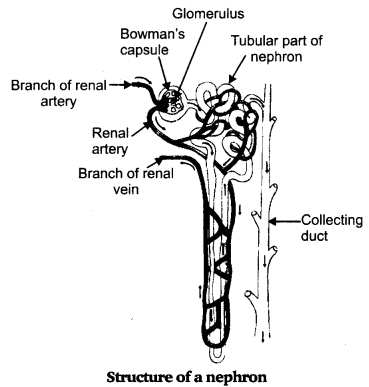
(iii) Urine formation: The water and impurities which is not reabsorbed is sent to a collecting duct. This filtrate contains more of dissolved nitrogenous wastes i.e. urea and hence it is termed as urine. From here the urine enters the ureter and is collected in urinary bladder.
Question 20. What are the methods used by plants to get rid of excretory products?
Answer:
Wastes excreted from plants are:
- Gaseous wastes – through stomata pores CO2 is given out during respiration and O2 is given out during photosynthesis.
- Liquid wastes (water) – through stomata pores by transpiration.
- Other wastes – are stored in leaves dead cells and the leaves fall off.
Some other waste products are stored as resins and gums in old xylem of the plant and other wastes are also thrown out from nodes into the soil.
Question 21. How is the amount of urine produced regulated?
Answer:
The amount of urine produced depends on how much excess water there is in the body and how much of dissolved waste there is to be excreted. On a hot day, when we sweat and lose a lot of body water and salts, most of the water and salts in kidney will be reabsorbed into the blood from the filtrate in the tubule.
Thus the volume of urine produced will be less. In winters, when we do not sweat a lot, a little water and salts will be reabsorbed and the volume of urine produced will be more. Thus there is perfect osmoregulation in the body.
In-Text Activities Solved
Activity 6.1
Answer:
Aim : To prove that chlorophyll is essential for photosynthesis.
Material Required : Potted plant with variegated leaves, sheet of paper, beaker, alcohol, water bath, Bunsen burner, dil. solution of iodine.
Procedure:
- Take a potted plant with variegated leaves e.g., money plant or crotons.
- Keep the plant in dark room for three days so that all the starch gets used up.
- Keep the plant in sunlight for about six hours.
- Pluck a leaf from the plant. Mark the green areas in it and trace them on a sheet of paper.
- Dip the leaf in boiling water for few minutes. After this immerse it in a beaker containing alcohol. Carefully place the above beaker in a water bath and heat till the alcohol begin to boil.
- The colour of the leaf changes from green to colourless as the chlorophyll is removed from it and the solution turns green.
- Now dip the leaf in dilute solution of iodine for a few minutes. Take out the leaf and rinse off the iodine solution.
Observations : The colour of the iodine on leaf at dark spots changes to blue-black and not anywhere else. Only that part of the leaf turns blue-black which showed the green areas.
Conclusion : This activity shows that chlorophyll is necessary for photosynthesis to prepare starch.
Activity 6.2
Answer:
Aim : To show that carbon dioxide is necessary for the starch formation.
Procedure : Take two healthy potted plants which are nearly the same size. Keep them in a dark room for three days. Now place each plant on separate glass plates. Place a watch-glass containing potassium hydroxide by the side of one of the plants. The potassium hydroxide is used to absorb carbon dioxide.

Material Required : Two potted plants, two bell shaped glass jars, watch glass, KOH, vaseline and glass plates. Cover both plants with separate bell-jars as shown in figure below.
Use vaseline to seal the bottom of the jars to the glass plates so that the set up is air tight. Keep the plants in sunlight for about two hours. Pluck a leaf from each plant and check for the presence of starch.
Observation : The leaf of the pot with KOH will not turn blue – black because KOH absorbs carbon dioxide required for photosynthesis. The leaf of pot without KOH will show blue – black colour due to presence of CO2 which is essential for starch formation in plants.
Conclusion : Carbon dioxide is essential for starch formation.
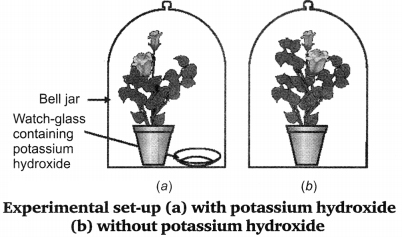
Activity 6.3
Answer:
Aim: To show the action of saliva on starch.
Procedure : Take 1ml starch solution (1%) in two test tubes (A and B).
- Add 1ml saliva to test tube A and leave both test tubes undisturbed for 20-30 minutes.
- Now add a few drops of dilute iodine solution to the test tubes.
- Observe the colour change.
Material Required : Starch solution, two test tubes, dilute iodine solution.
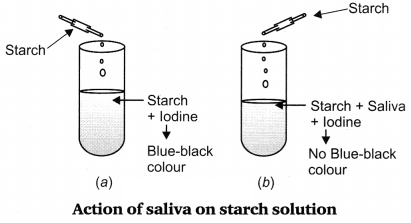
Observations : In test tube A → starch + saliva + iodine → No colour change.
In the test tube B → starch + iodine → colour changes to blue-black.
Conclusion: This activity shows that in the test tube A, saliva acts on the starch and digest it, changes it into simple sugar. Whereas in the test tube B, starch shows the colour change with iodine.
Activity 6.4
Answer:
Aim: To show presence of carbon dioxide in exhaled air.
Procedure :
- Take some freshly prepared lime water in a test tube. Blow air through this lime water.
- Use a syringe to pass air through some fresh lime water taken in another test tube. Lime water turns milky after some time.
Material Required : Test tube, freshly prepared lime water, delivery tube, syringe.
Observation : Limewater turns milky in test A and in test B it turns milky after sometime.
Conclusion : This activity shows that more carbon dioxide is present in the exhaled air of human beings than the air.

Activity 6.5
Answer:
Take some fruit juice or sugar solution and add some yeast to this. Take this mixture in a test tube fitted with one-holed cork. Fit the cork with a bent glass tube. Dip the free end of the glass tube into a test tube containing freshly prepared lime water.
Observation : Lime water turns milky. This activity tells us that one of the product of fermentation is carbon dioxide.
Activity 6.6
Answer:
Observe the fish in an aquarium. They open and close their mouth and the gill-slits behind their eyes also open and close. Count the number of times the fish opens and closes its mouth in a minute and compare this number with your breathing rate.
Observation : The rate of breathing in fish is much faster than the human beings.
Activity 6.7
Answer:
Visit a health centre in your locality and find out what is the normal range of haemoglobin count in human beings, children and adults – differently in men and women.
Observation : The range of haemoglobin in male is more than the female and it is lowest in children.
Activity 6.8
Answer:
Aim : To show the process of transpiration.
Material Required : Two small pots, soil, plant, stick, plastic sheet.
Procedure : Take two small pots of approximately the same size and having the same amount of soil. One should have a plant in it. Place a stick of the same height as the plant in the other pot.
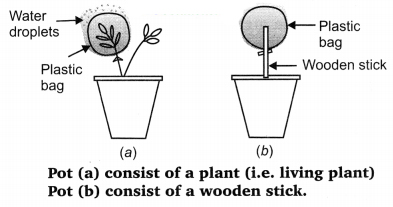
Cover the soil in both pots with a plastic sheet so that moisture cannot escape by evaporation. Cover both sets, one with the plant and the other with the stick, with plastic sheets and place in bright sunlight for half an hour.
Observation : Pot with plant – small drops of water on the plastic sheet covering the plant is seen. Pot with a stick – no water droplets are seen on the plastic sheet covering the stick.
Conclusion : This activity shows that living plants absorb water from the soil and water gets transported to the leaves. Loss of water takes place by leaves through the process of transpiration.
Follow on Facebook page – Click Here
Google News join in – Click Here
Read More Asia News – Click Here
Read More Sports News – Click Here
Read More Crypto News – Click Here